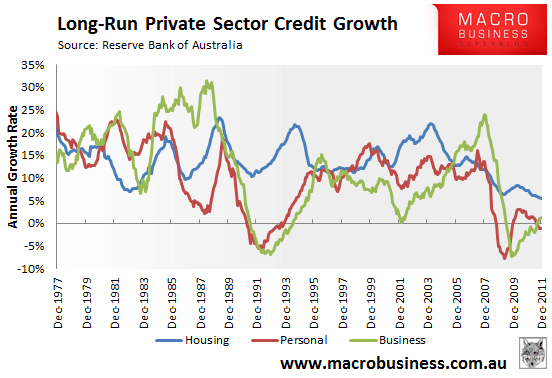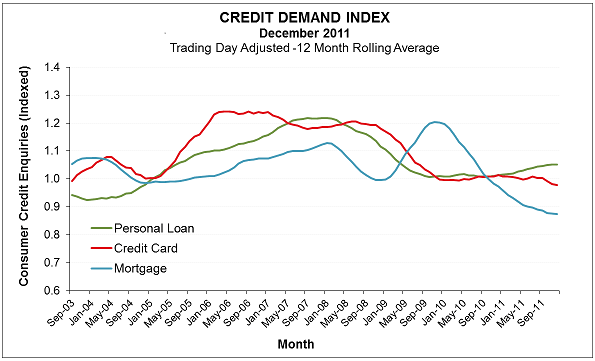
Earlier this month, the Reserve Bank of Australia (RBA) released its credit aggregates data for the month of December, which revealed that overall private sector credit is growing at the slowest pace since the 1990-91 recession, with mortgage credit growing at the slowest rate in the dataset’s 34-year history:

Yesterday, we received further confirmation of the disleveraging currently underway in the Australian economy with the release of Veda’s Consumer Credit Demand Index for the December quarter of 2011. The below chart summarises the results, with the number of mortgage enquiries falling for the eighth consecutive quarter and plumbing all time (8-year) lows, and credit card demand also cratering:
According to Veda:
SYDNEY, Australia. February 9, 2012 – Veda, Australasia’s leading provider of commercial and consumer data intelligence and insights today released the results of the Consumer Credit Demand Index, which revealed a sharp decline in credit card applications across Australia in the last quarter of 2011. This bucked the trend from earlier quarters in 2011, pointing to a slowdown in consumer demand for credit during the final quarter of the year. Compiled by Veda since 2004, the Consumer Credit Demand Index is a quarterly analysis of changes in consumer demand for credit cards, personal loans and mortgages across Australia.
“To see such a marked reduction in the use of credit by consumers in the period leading up to the Christmas holidays is unusual; the final quarter of the year is typically a time when there is stronger demand from consumers to obtain new credit, ” commented Angus Luffman, Head of Consumer Risk at Veda. “Contrary to the usual trend, all states saw demand for credit cards and personal loans retreat from what had been an upward trend throughout 2011, leaving credit demand flat on 2010. As a leading indicator of economic activity and trends, the Index supports other economic data suggesting that consumers are being more circumspect.”
Credit card applications recorded their largest December quarter drop since 2009 (-9.9%) and the second largest year-on-year Q4 drop in six years. Queensland registered the biggest year-on-year decline (-14.5%) followed by New South Wales (-11.8%) and Victoria (-7.7%). In addition to consumers being more circumspect in their use of credit, the decline in credit card application may be attributed to the rise in the use of debit cards and the introduction of responsible lending laws in 2011 which has led to more steps being added to credit card application processes.
Personal loan applications continued to grow, albeit at a slower rate, up 2.4% for the December quarter – the fifth consecutive quarterly rise, following 11 previous consecutive decreases dating back to March 2008. Interestingly, personal loan volumes started to exceed those of credit cards for the first time, for six out of the twelve months, culminating in a 3.8% increase over the course of 2011. The rise may partially be attributed to a seasonal spike in demand for car loans around the end of the year, however, there was growing demand from a younger demographic in addition to a clear rise in Western Australia.
Mortgage enquiries fell for the eighth consecutive quarter, declining by a total of 9.9% year-on-year, representing a continuation of the steady bottoming out recorded since the global financial crisis. The decline was reflected in all states with the exception of New South Wales where mortgage demand grew by 4.7%. The result for New South Wales is a further improvement on that seen in the September quarter, where mortgage demand was flat after seven quarters of decline.
Arguably, the overall number of mortgage enquiries would have been even lower in the December quarter had first home buyer demand in New South Wales not been pulled forward by the announced cancellation of first home buyer stamp duty concessions on 31 December 2011.
Now we await Monday’s release of the ABS housing finance commitments data for confirmation (or not) of the extent to which mortgage credit demand has slowed. Our other leading indicator, AFG origination data, is not especially encouraging, for either December or January.


